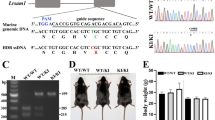Abstract
Hereditary sensory and autonomic neuropathy type II (HSAN II) leads to severe mutilations because of impaired nociception and autonomic dysfunction. Here we show that loss-of-function mutations in FAM134B, encoding a newly identified cis-Golgi protein, cause HSAN II. Fam134b knockdown results in structural alterations of the cis-Golgi compartment and induces apoptosis in some primary dorsal root ganglion neurons. This implicates FAM134B as critical in long-term survival of nociceptive and autonomic ganglion neurons.
This is a preview of subscription content, access via your institution
Access options
Subscribe to this journal
Receive 12 print issues and online access
$209.00 per year
only $17.42 per issue
Buy this article
- Purchase on Springer Link
- Instant access to full article PDF
Prices may be subject to local taxes which are calculated during checkout


Similar content being viewed by others
References
Hughes, R. Pract. Neurol. 8, 396–405 (2008).
Lafreniere, R.G. et al. Am. J. Hum. Genet. 74, 1064–1073 (2004).
Shekarabi, M. et al. J. Clin. Invest. 118, 2496–2505 (2008).
Tang, W.K. et al. Int. J. Mol. Med. 19, 915–923 (2007).
Linstedt, A.D. & Hauri, H.P. Mol. Biol. Cell 4, 679–693 (1993).
Donaldson, J.G. & Lippincott-Schwartz, J. Cell 101, 693–696 (2000).
Seemann, J., Jokitalo, E., Pypaert, M. & Warren, G. Nature 407, 1022–1026 (2000).
Voeltz, G.K., Prinz, W.A., Shibata, Y., Rist, J.M. & Rapoport, T.A. Cell 124, 573–586 (2006).
Altan-Bonnet, N. Methods Mol. Biol. 390, 309–328 (2007).
Harper, A.A. & Lawson, S.N. J. Physiol. (Lond.) 359, 31–46 (1985).
Levi-Montalcini, R. Science 237, 1154–1162 (1987).
Indo, Y. et al. Nat. Genet. 13, 485–488 (1996).
Einarsdottir, E. et al. Hum. Mol. Genet. 13, 799–805 (2004).
Lu, B., Pang, P.T. & Woo, N.H. Nat. Rev. Neurosci. 6, 603–614 (2005).
Züchner, S. & Vance, J.M. J. Mol. Med. 83, 935–943 (2005).
Acknowledgements
We are grateful to all affected individuals and their relatives who participated in the study. This work was supported by grants of the Werner-Otto-Stiftung to I.K., a Methusalem grant of the University of Antwerp and grants of the DFG and IZKF Jena to C.A.H. We thank T. Deufel for continuous support and J. Müller for help with the implementation of the lentiviral-mediated knockdown. We acknowledge the excellent technical assistance of W. Bigott, K. Küchler and S. Vanek. This work was also supported by the University of Antwerp, the Fund for Scientific Research (FWO-Flanders), an FFM grant of the Universitätsklinikum Hamburg Eppendorf, the Medical Foundation Queen Elisabeth (GSKE) and the Interuniversity Attraction Poles P6/43 program of the Belgian Federal Science Policy Office (BELSPO). A.R. and J.B. are supported by PhD fellowships of the Institute for Science and Technology (IWT) and FWO-Flanders, respectively. J.S. is a Heisenberg fellow of the Deutsche Forschungsgemeinschaft.
Author information
Authors and Affiliations
Contributions
I.K. performed genetic and functional assays, coordinated the study and wrote the manuscript. T.P., J.C.H., A.K.H. and C.K. developed and performed functional assays. D.S. and A.R. performed molecular genetic analyses. J.B., J.S., H.T., S.A.F., P.D.J. and V.T. provided DNA samples and collected clinical data. G.N. and P.N. performed genetic mapping. A.G. edited the manuscript. C.A.H. initiated, planned and coordinated the study and wrote the manuscript.
Corresponding authors
Supplementary information
Supplementary Text and Figures
Supplementary Methods, Supplementary Tables 1 and 2 and Supplementary Figures 1–8 (PDF 1001 kb)
Rights and permissions
About this article
Cite this article
Kurth, I., Pamminger, T., Hennings, J. et al. Mutations in FAM134B, encoding a newly identified Golgi protein, cause severe sensory and autonomic neuropathy. Nat Genet 41, 1179–1181 (2009). https://doi.org/10.1038/ng.464
Received:
Accepted:
Published:
Issue Date:
DOI: https://doi.org/10.1038/ng.464
This article is cited by
-
Autophagy: Regulator of cell death
Cell Death & Disease (2023)
-
Molecular characterization of wild-type and HSAN2B-linked FAM134B
Molecular Biology Reports (2023)
-
Global dispersal and adaptive evolution of domestic cattle: a genomic perspective
Stress Biology (2023)
-
Macroautophagy in CNS health and disease
Nature Reviews Neuroscience (2022)
-
The Regulatory Role of Reticulons in Neurodegeneration: Insights Underpinning Therapeutic Potential for Neurodegenerative Diseases
Cellular and Molecular Neurobiology (2021)



